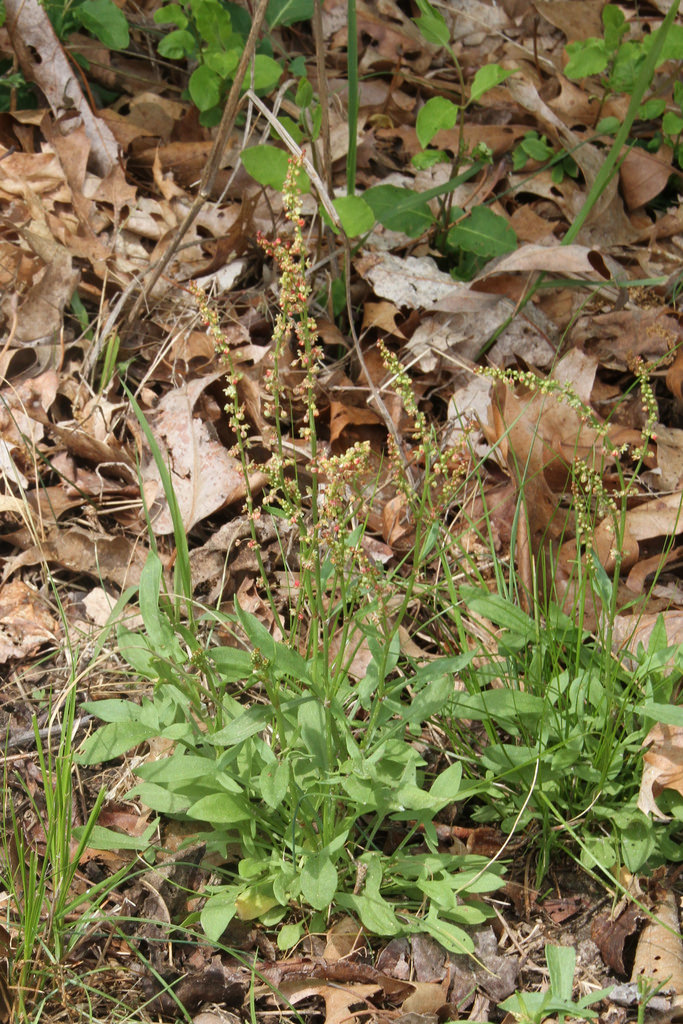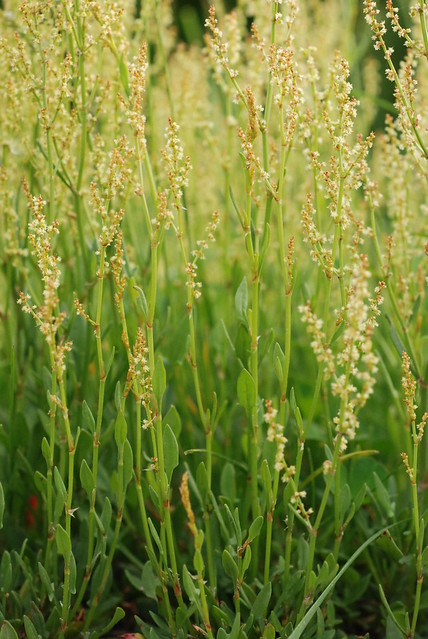Map Snapshot

























286 Records
Status
Common Sheep Sorrel is a native of Europe and now occurs nearly worldwide. It grows in open areas, such as pastures, natural areas, and crop land.
Relationships
Host plant for the butterfly species American Copper. Common Sheep Sorrel contains oxalic acid and can be toxic to livestock, especially sheep and cattle, if eaten in large quantities. Livestock often avoid it, though, because of its sour taste.
Seasonality Snapshot
Source: Wikipedia
This article needs additional citations for verification. (May 2014) |
| Rumex acetosella | |
|---|---|

| |
| Scientific classification | |
| Kingdom: | Plantae |
| Clade: | Tracheophytes |
| Clade: | Angiosperms |
| Clade: | Eudicots |
| Order: | Caryophyllales |
| Family: | Polygonaceae |
| Genus: | Rumex |
| Species: | R. acetosella
|
| Binomial name | |
| Rumex acetosella | |
| Synonyms[1] | |
|
Acetosella vulgaris (W.D.J. Koch) Fourr. | |
Rumex acetosella, commonly known as red sorrel, sheep's sorrel,[2] field sorrel and sour weed, is a species of flowering plant in the buckwheat family Polygonaceae. Native to Eurasia and the British Isles,[3] the plant and its subspecies are common perennial weeds. It has green arrowhead-shaped leaves and red-tinted deeply ridged stems, and it sprouts from an aggressive and spreading rhizome. The flowers emerge from a tall, upright stem. Female flowers are maroon in color.
Description
[edit]Rumex acetosella is a perennial herb which spreads via rhizomes. It has a slender and reddish, upright stem that is branched at the top, reaching a height of 50 centimetres (20 inches).[4] The arrow-shaped leaves are small, about 2.4–5 cm (1–2 in) long and .5–2 cm (1⁄4–3⁄4 in) wide, with pointed lobes at the base.[4] It blooms during March to November, when yellowish-green (male) or reddish (female) flowers develop on separate plants at the apex of the stem, which develop into the red fruits (achenes).
It should not be confused with the similarly named R. acerosella, which also contains oxalic acid and should not be eaten in excess.[5]
Distribution and habitat
[edit]Native to Eurasia and the British Isles,[3] R. acetosella has been introduced to most of the rest of the Northern Hemisphere. It is commonly found on acidic, sandy soils in heaths and grassland.[3] It is often one of the first species to take hold in disturbed areas, such as abandoned mining sites, especially if the soil is acidic.
The plant is dioecious, with separate male and female plants. It has been found that in early successional habitats, there are relatively more female plants, while in later successional stages, male plants are more common.[6]
The plant has been found as an invasive species in Sphagnum peatlands disturbed by peat extraction in southern Patagonia.[7]
Ecology
[edit]Livestock will graze on the plant, but it is not very nutritious and is toxic in large amounts because of oxalates. Italian agronomist Nicola Onorati (1764–1822) first discovered that the plant damages the teeth of animals that crop this plant because of the oxalic acid it contains.[8][9]
Ground-feeding songbirds eat the seeds, and larger animals like rabbits and deer browse the greens.[10]
The American copper or small copper butterfly depends on it for food, although its larvae can consume some related plants.
The plant is widely considered to be a hard-to-control noxious weed due to its spreading rhizome. Blueberry farmers are familiar with the weed because it thrives in the same conditions under which blueberries are cultivated.
Toxicity
[edit]The plant contains oxalic acid and derivatives, known as oxalates.[8][9]
Uses
[edit]The leaves can be eaten raw or cooked, with the water changed to reduce its strong taste.[11][5] The oxalic acid they contain lend them a somewhat sour taste.[12] There are several uses of sheep sorrel in the preparation of food including a garnish, a tart flavoring agent, a salad green,[11] and a curdling agent for milk in cheese-making.[citation needed] The leaves have a lemony, tangy or rhubarb-like tart flavor.[11]
References
[edit]- ^ "Acetosella vulgaris". Germplasm Resources Information Network. Agricultural Research Service, United States Department of Agriculture. Retrieved 16 December 2017.
- ^ Brian Proudley; Valerie Proudley (1989). Heathers in Colour (2nd ed.). Blandford Press. p. 37. ISBN 0713714204.
This will indicate an acid or neutral soil as will the presence of Sheep's Sorrel (Rumex acetosella).
- ^ a b c Stace, C. A. (2010). New Flora of the British Isles (Third ed.). Cambridge, U.K.: Cambridge University Press. p. 450. ISBN 9780521707725.
- ^ a b Elias, Thomas S.; Dykeman, Peter A. (2009) [1982]. Edible Wild Plants: A North American Field Guide to Over 200 Natural Foods. New York: Sterling. p. 121. ISBN 978-1-4027-6715-9. OCLC 244766414.
- ^ a b The Complete Guide to Edible Wild Plants. United States Department of the Army. New York: Skyhorse Publishing. 2009. pp. 93, 115. ISBN 978-1-60239-692-0. OCLC 277203364.
{{cite book}}: CS1 maint: others (link) - ^ Houssard, C.; Escarre, J.; Vartanian, N. (1992). "Water stress effects on successional populations of the dioecious herb, Rumex acetosella L". New Phytologist. 120 (4): 551–559. doi:10.1111/j.1469-8137.1992.tb01805.x.
- ^ Domínguez, Erwin; Bahamonde, Nelson; Muñoz-Escobar, Christian. "Efectos de la extracción de turba sobre la composición y estructura de una turbera de Sphagnum explotada y abandonada hace 20 años, Chile" [Effects of peat extraction on the structure and composition of Sphagnum peatland exploited and abandones for 20 years, Chile]. Anales del Instituto de la Patagonia (in Spanish). 40 (2): 37–45.
- ^ a b Vachetta, p. 499
- ^ a b Delle cose rustiche, vol. 3
- ^ Niering, William A.; Olmstead, Nancy C. (1985) [1979]. The Audubon Society Field Guide to North American Wildflowers, Eastern Region. Knopf. p. 708. ISBN 0-394-50432-1.
- ^ a b c Nyerges, Christopher (2017). Foraging Washington: Finding, Identifying, and Preparing Edible Wild Foods. Guilford, CT: Falcon Guides. ISBN 978-1-4930-2534-3. OCLC 965922681.
- ^ Fagan, Damian (2019). Wildflowers of Oregon: A Field Guide to Over 400 Wildflowers, Trees, and Shrubs of the Coast, Cascades, and High Desert. Guilford, CT: FalconGuides. p. 218. ISBN 978-1-4930-3633-2. OCLC 1073035766.
Sources
[edit]- Vachetta, Andrea Alfonso (1877). Elementi di patologia chirurgica degli animali domestici. Milan: Ulrico Hoepli. p. 499.
External links
[edit]- "Rumex acetosella". Plants for a Future.
- "Rumex acetosella". Calflora. Berkeley, California: The Calflora Database.
- Rumex acetosella in the CalPhotos photo database, University of California, Berkeley
- Weed of the Week - United States Department of Agriculture Forest Service
- Missouri Plants, More pictures












